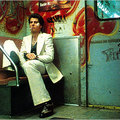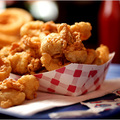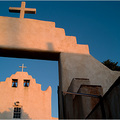ONLY the barest of murmurs greeted the arrival at the bustling Café Vian of a dozen or so kilt-clad Scots in their late teens and early 20’s and what looked to be their middle-age coach, also in tartan. They ordered a round of vodka shots and erupted in Highland cheers, drawing worried glances from patrons hovering over sweet multicolored cocktails at nearby tables.
Finally, the Scots’ skinny young waiter valiantly ordered them to keep it down. “This is not a soccer bar,” he told them.
Cultures have been clashing in Budapest for a good many centuries, and usually not to Hungary’s benefit. But through several waves of occupation, tyranny and heroic revolt, it has become one of the few places on earth that have learned the trick of transforming that clash into music.
A spectacularly beautiful and subversively lively old royal capital, Budapest has in the last decade or so languished in the shadow of Prague, which emerged more quickly as a tourist destination after the Communist era. Even Arthur Phillips’s best-selling 2002 novel, “Prague,” was actually about expatriates in Budapest dreaming of the higher life across the Czech frontier.
But now the foreign investment that only trickled into Budapest in the 1980’s has become a gusher, spilling new and ostentatious hotels, boutiques for luxury brands like Salvatore Ferragamo and Louis Vuitton, teeming pedestrian-only nightlife districts and smoky bars full of satirical and world-weary graffiti. Budapest seems ready to claim the light.
For more than a decade — since work-related happenstance led me there — Budapest has been one of my favorite places in Europe. When I first came to know it, the city was still fresh from the Soviet collapse, an eager place full of downtrodden buildings, dingy marketplaces, makeshift nightclubs, gypsy violinists and restaurant after restaurant serving goulash and little else. In Buda, the once aristocratic old capital on the west side, bicycles navigated near-desolate cobbled medieval lanes. Russian caviar and Hungarian foie gras could be had for a song.
When a local paper advertised the arrival of a six-month-old Hollywood movie (“Sneakers,” with Robert Redford), I took a rickety trolley to the foot of the Buda Hills and found an old garage with a white sheet hung from the cinderblock wall and a few dozen happy families seated on wooden benches, unpacking dinner. The projector made an awful racket. Everyone had a wonderful time, eating and laughing, and I walked back to my Danube hotel alone through dark Buda streets.
When I went back this summer, I found a city very much changed, and not just because the movies are in multiplexes.
Budapest, with a population of more than 1.7 million, still has bedraggled and struggling outer districts. But Nagyvasarcsarnok, the Central Market Hall in Pest, is a bright, dynamic place full of paprika, aromatic food stalls and sweet Tokaji wine. Sidewalk cafes are alive with thrift-shop fashionistas, canoodling couples and joyful chatter in a dozen languages. In Buda, tourist buses cluster like seagulls at Castle Hill, discharging sightseers from all over the world.
Yes, goulash — that old soupy peasant staple of beef stewed with vegetables and paprika — is still on pretty much every menu, but I also found the world’s cuisines on offer. Where $5 once bought a brick of foie gras big enough to gorge four adults, a few bites in a small appetizer serving now run around triple that.
A collision of forces is transforming Budapest into one of the continent’s liveliest, prettiest and most animated capitals. Attractive prices, especially for housing, have set off a mini-invasion of foreigners setting up second homes in the stylish 19th-century apartment blocks of central Pest. Retail chains from around the world have followed, along with the hoteliers and commercial developers.
The rush of foreign capital and the rising standard of living for Budapesters lucky enough to catch the wave has helped the city resuscitate many lavish buildings that had fallen into ruin, from the spectacular Secessionist-style Gresham Palace — now a Four Seasons Hotel — to lesser-known gems like the Egyetemi Konyvtar (University Library), a pale yellow confection of wedding-cake swirls, and the stately mirror-image Klotild-Palotak buildings, whose imposing Baroque towers rise like sentries at the foot of the Elizabeth Bridge.
“Ten years ago, you’d come to Budapest and it was cheap and a little rough and everything was in cash,” said Colin Burns, who was visiting the city for the fourth time with his Welsh choir group. “Now it’s all cutting edge and credit cards and trendy restaurants. There’s better Italian food here than back in Wales.”
There have been missteps. The New York Cafe, long a center of Hungarian intellectual life, was a smoky, murmuring and impossibly grand space where patrons seemed to have stepped from an Eric Ambler thriller. It has become a gaudy patisserie attached to a swank hotel. The huge and hugely popular Westend Center shopping mall is a flavorless glass-and-steel arc of shops wrapping around the back side of Gustav Eiffel’s soaring Nyugati train station.
Yet odd, distinct elements speak to the atmosphere of dynamic upheaval. An underground market of cheap clothes and bad CD’s blends seamlessly into the mall above it, asserting an older, Oriental culture that refuses to be drowned entirely by American-style blandness. Big, clanging storefront casinos sit comfortably beside the boutiques and bookstores.
A member of the European Union since 2004, Hungary still uses its old currency, the forint, and only its most optimistic economists hope for a conversion to the euro as soon as 2010. Budget deficits are swollen after years of overspending by Hungary’s Socialist government, which was re-elected in April.
At the same time, wages are up and the standard of living has noticeably improved, at least for some. Those new luxury boutiques and elegant cafes are not just for foreigners.
MY wife, Barbara, and I divided this trip in half: two nights in Buda, with its domed Habsburg palaces and crenellated fortifications stretching along craggy hilltops west of the Danube, and two in Pest, the more populous 19th-century commercial city of grand boulevards on the flats east of the river.
Tourism is on the rise in Hungary, up nearly 7 percent in 2005 over 2004, according to the Hungarian Tourist Office. Yet escaping the crowds is still quite easy.
In Buda, while tourists concentrated on Castle Hill, we found everyday life in the sprawling shopping mall and food market near Moscow Square. Perfectly coiffed mothers in blue jeans pushed baby strollers through narrow aisles of peppers and cabbages while older, weary workmen in gray shirts and kerchiefs sipped tumblers of blood-red wine from nearby lunch counters.
An elderly woman pushing a metal cart paused to scream at a young couple who had parked their Mercedes convertible illegally. They smiled at her impassively and strode away.
Even on Castle Hill, the crowds thin once you get away from Matthias Church, with its architectural elements from the 16th century, when it was a mosque; the 17th, when it grew a Baroque facade; and the 19th, when Gothic design celebrated Habsburg supremacy.
A decade ago, I had a memorable meal at the foot of Castle Hill, with strolling gypsy violinists pouring out the Brahms at a place called Kacsa Vendeglo that looked as if it hadn’t changed its menu or decorations since the Great War. On this visit, we found a fresh violinist, still playing Brahms though he had added some Billy Joel and had his CD’s for sale.
The tablecloths were white and the menu was still an old-fashioned ramble through Hungary’s familiar dishes, emphasizing duck (kacsa in Hungarian) in a blizzard of forms. The place is decidedly out of step with Budapest’s cutting edge, which leans toward fusion at places with names like Baraka, Kepiro and Voro es Feher Borbar (Red and White Wine Bar). Across the river in Pest, a central pedestrian strip called Vaci utca contained the most wandering foreigners, who were weaving among buskers and trying to remember where their tour buses were parked.
Two semicircular boulevards, the Inner Ring and the Outer Ring, end at Danube bridges and define the heart of Pest. Local residents can be found by day in American-style malls along the Outer Ring or in one of the new pedestrian-only shopping areas, echoes of Vaci utca, that are now sprinkled around the city and serve as centers of its street life. One of the biggest, Raday utca, a little east of the Central Market Hall, is five blocks of sidewalk tables, multiethnic restaurants and music-pulsing bars.
“We came up from Vienna by boat and just wandered around all day and just found our way here,” said Carlos Hererra, who runs a design store near Los Angeles and was sipping a tall glass of wheat beer one day at a Raday utca cafe. “Just sitting here for an hour, I’ve heard more foreign languages than I heard in three days in Austria or that I ever hear back in Orange County.”
Tourists and locals mingle in the Great Market Hall, where shoppers should be prepared to prowl. The price of a 400-gram tin of foie gras ranged from $37 to $45, depending on the stall. On the market’s second level are a series of inexpensive minicafes offering German beer, Hungarian wine and all sorts of sausages, pies, sandwiches and paprika stews.
On my early visits to Budapest, I often came across other visitors who had just arrived from Prague or were about to go there. This time, most tourists we met were visiting only Budapest or had arrived from Vienna on one of the Danube cruises now connecting the two old capitals of the Austro-Hungarian Empire.
New in the past half-dozen years, the riverboats seemed emblematic — part of Budapest’s shrugging off its midcentury past, when connections were to places like Prague and Krakow, to reflect an older and more durable relationship. One couple we met, travelers from San Diego fresh off a river boat, said they were delighted with Budapest’s street bustle and food — and its prices, significantly lower than those they had found in Vienna.
Most cities have different day and night personalities, but the contrast in Budapest seems particularly stark, almost as if an entirely different geography and cast of characters has been imposed upon the place.
The Danube comes to life as a kind of a kind of floating smorgasbord of moored barges: one offers jazz dinners, another a pulsing disco, yet another a quiet seafood restaurant. Places like Raday utca and Liszt Ferenc Square, just off the fashionable boulevard of Andrassy, attract crowds that are younger, more chic and louder. Often, a club catering to 20-somethings on the prowl reveals itself down a dark Pest side street with a dim glow from a door opening into a hidden warren of lounge rooms and lantern-lit gardens.
For a symbol of how Budapest has changed, an obvious first choice would be Roosevelt Square, at the foot of the Chain Bridge. Previously dominated by hulking old buildings and the state-operated Forum Hotel (now an Inter-Continental), it is now overlooked by the Gresham Palace and a gaudy casino, and it is thick with limos.
If you’re looking for the heart of the city today, I’d make a case for sampling Lizst Ferenc Square. That’s where we found Café Vian, in which Budapest’s clashing cultures made a particularly sweet sound. The youthful crowd, hovering over sweet cocktails and yelling to be heard in the din, was flecked with a handful of older faces, mostly fresh from hearing Stravinsky and Gulda at the venerable Zeneakademia a few steps away.
The State Opera House was doing Wagner that night, “Die Meistersinger von Nürnberg,” so no telling when that crowd would arrive and what mood they’d be in.
Perhaps a generous, $9 plate of chicken paprika or a $7.25 helping of tagliatelle would get their heads out of Wagner and back into Liszt, where they belong. Who knows, they might even share a round with the Scottish soccer team, assuming everyone is still playing nice together.
VISITOR INFORMATION
HOW TO GET THERE
Malev Hungarian Airlines (www.malev.hu) and Delta Airlines offer nonstop flights between New York and Budapest’s Ferihegy Airport. An Internet search for late September found round-trip fares starting around $840.
A taxi ride from the airport to central Pest, where most hotels are situated, should run about 4,000 forints, with a small tip, which is about $18 at 220 forints to the dollar. But some drivers might charge closer to 6,000 if you don’t shop around.
GETTING AROUND
A three-day metro pass (2,500 forints) gives free access to all subway lines and trams. For 6,500 forints, a three-day Budapest Card adds discounts for museums, attractions and restaurants. See www.budapestinfo.hu/en/budapest_card.
WHERE TO STAY
At the Corinthia Grand Hotel Royal (Erzsebet korut 43-49; 36-1-479-4000; www.corinthiahotels.com), peaked glass roofs enclose once open courtyards around an opulent inner structure. The 414 rooms start at 40,680 forints.
Nearby is the Boscolo New York Palace Hotel (Erzsebet korut 9-11; 36-1- 886-6111; www.boscolohotels.com), even more gleaming and gilded than the Corinthia. It has 107 rooms, starting at 50,000 forints. The legendary New York Cafe is adjacent.
The city’s premier hotel, the 179-room Four Seasons Gresham Palace on Roosevelt Square (36-1-268-3000; www.fourseasons.com/budapest), is sophisticated and luxe. Rooms start at 87,000 forints.
On the Buda side of the Danube, the starkly modern art’otel (Bem rakpart 16-19; 36-1-487-9487, www.artotel.hu ), offers sweeping views of the Chain Bridge and the ornate Parliament building, and is a short walk from Castle Hill. The 164 rooms start at $184, $242 with a river view.
WHERE TO EAT
Where goulash once ruled all and still makes a pretty good showing even at the fanciest places, Budapest is now home to pretty much all cuisines. One of the earliest harbingers of this trend was Restaurant Lou Lou, a French-leaning bistro unobtrusively nestled at Vigyazo Ferenc utca 4 (36-1-312-4505), on an otherwise unremarkable side street between Roosevelt Square and Parliament. An antique horse perches over the bar; huge mirrors glisten on the salmon walls while spot lighting illuminates individual tables. A foie gras appetizer is 3,200 forints, and scallops and gravlax are 3,300; among main courses, a duck duo is 3,900 forints and sautéed goose liver is 4,100. Yes, there is goulash, for 1,400 forints.
Costes, at Raday utca 4 (36-1-219-0696), is one of the nicer places along Raday utca, a bustling pedestrian strip, with a menu that stresses game and includes French, Italian and Hungarian flavors. A game consommé or goulash runs about 890 forints, a rack of venison with wild mushrooms costs 4,590 forints and a monkfish filet perched improbably atop a thick omelet is 4,000.
Less than a block away is the louder and more informal Soul Café, Raday utca 11-13 (36-1-217-6986), with all manner of Mediterranean dishes in a California-style setting. A mozzarella and tomato salad is 1,500 forints, asparagus cream soup 913 forints, a Thai cashew chicken only 2,200 and a delicious butterfish in lime sauce over jasmine rice 2,936. Goulash, if you must, is 1,500 forints.
For a blast of old Budapest, Kacsa Vendeglo is across the river in the Watertown area of Buda, at Fo utca 75, (36-1-201-9992). The specialty here is duck in many forms — in a strudel, crispy, stuffed with prunes, as a pâté, homestyle, Tisza style, Rozsnyai style or atop mashed apple. If you’re sick of duck, there’s also goose, as well as pike, perch, lobster, chicken and sirloin steak Budapest style. Paprika plays a prominent role. The wandering violinist accepts requests and tips.
A particularly pleasant place to begin the day is the Angelika cafe (36-1-212-3784), tucked into one wing of an old church building on Batthyany with a terrace overlooking the river. Inside, the dark rooms are arched and illuminated through stained glass. A café American runs just 400 forints and a fortifying four-egg omelet about 980.
WHERE TO DRINK
The swank spot is the Gresham Bar, just off the lobby in the Four Seasons Gresham Palace Hotel on Roosevelt Square, just at the Pest foot of the Chain Bridge (36-1-268-3000). The style is international business luxe, and there’s the marble, the dark wood and the recessed lighting to prove it. A glass of palinka, the traditional fruit brandy, is 2,200 forints, and a glass of Calvados 2,400. Good free snacks, though.
For a more atmospheric, smoky and downscale alternative, there is West Balkan, a warren of darkly lit rooms at Kisfaludy utca 36 (36-1-371-1807), where a happy crowd lived out its John le Carré fantasies — or maybe that was just me. The Calvados here was 550 forints. Beers, of which there were dozens on offer, averaged around 480 forints.
The coffeehouse is also a Budapest staple, beginning with the venerable Café Gerbeaud on Vorosmarty Square in the center of Pest (36-1-429-9000). This 19th-century palace with a huge outdoor patio spilling into the square has been around since 1858 and is famous for its pastries. A chocolate torte is 590 forints and a cappuccino 680.






